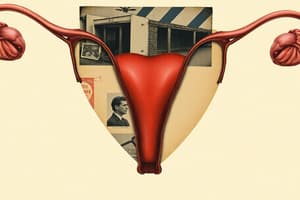Podcast
Questions and Answers
What is pelvic organ prolapse?
What is pelvic organ prolapse?
Most common indication for hysterectomy in women aged >50 years; happens when there is weakness in supporting structures of the pelvic floor.
What are the classifications of pelvic organ prolapse?
What are the classifications of pelvic organ prolapse?
Anterior wall Cystocele, Urethrocele, Relaxed perineum, Rectocele, Enterocele, Secondary vault prolapse.
What are the three tiers of vaginal support?
What are the three tiers of vaginal support?
Upper tier, Middle tier, Inferior tier.
What symptoms may indicate pelvic organ prolapse?
What symptoms may indicate pelvic organ prolapse?
Which of the following are considered risk factors for pelvic organ prolapse? (Select all that apply)
Which of the following are considered risk factors for pelvic organ prolapse? (Select all that apply)
How is pelvic organ prolapse assessed?
How is pelvic organ prolapse assessed?
What is the Baden-Walker system?
What is the Baden-Walker system?
What does the POP-Q system involve?
What does the POP-Q system involve?
What factors determine the management of pelvic organ prolapse?
What factors determine the management of pelvic organ prolapse?
What are the underlying risk factors that should be treated?
What are the underlying risk factors that should be treated?
What is the first line treatment for conservative management of pelvic organ prolapse?
What is the first line treatment for conservative management of pelvic organ prolapse?
Pelvic floor muscle training is also known as _____ exercise.
Pelvic floor muscle training is also known as _____ exercise.
Flashcards are hidden until you start studying
Study Notes
Pelvic Organ Prolapse Overview
- Common indication for hysterectomy in women over 50 due to weakness in pelvic floor support structures.
Classification of Pelvic Organ Prolapse
- Anterior Wall Prolapse:
- Cystocele: Herniation of the bladder through laxity in the upper anterior vaginal wall.
- Urethrocele: Herniation of the urethra through a lax lower third of the anterior vaginal wall; may occur with cystocele (cystourethrocele).
- Posterior Wall Prolapse:
- Relaxed Perineum: Torn perineal body causing a bulge in the lower posterior vaginal wall.
- Rectocele: Herniation of the rectum through laxity in the middle third of the posterior vaginal wall.
- Enterocele: Herniation of the pouch of Douglas; can contain small bowel, occurs due to laxity in the upper third of the posterior wall.
- Secondary Vault Prolapse: Occurs after hysterectomy due to inadequate repair or undetected enterocele.
Levels of Vaginal Support
- Upper Tier: Endopelvic fascia over uterus, round and broad ligaments, pelvic cellular tissues.
- Middle Tier: Pericervical ring and pelvic cellular tissues.
- Inferior Tier: Includes levator ani (pelvic floor muscles), endopelvic fascia, levator plate, perineal body, and urogenital diaphragm.
Clinical History
- Symptoms include a sensation of vaginal bulge, discomfort, and difficulty with sexual activity.
- Additional signs may include stress incontinence, voiding difficulties, and backaches.
- Up to 50% of women may be asymptomatic, with findings being incidental.
Risk Factors
- Parity, especially after difficult labor, multiple births, or large babies.
- Menopause causes tissue weakening due to reduced estrogen.
- High Body Mass Index (BMI) exacerbates pelvic pressure.
- Previous pelvic surgeries increase risk.
- Conditions increasing intra-abdominal pressure: heavy lifting, prolonged coughing, chronic constipation.
- Genetic predisposition linked to connective tissue disorders such as Ehlers-Danlos syndrome.
Assessment Techniques
- Evaluation performed during Valsalva maneuver (straining/standing) to ascertain the lowest point of prolapse.
- Utilizes grading systems like Baden-Walker and POP-Q for assessment.
Baden-Walker System
- A specific grading system for evaluating the degree of prolapse but lacks detailed information provided.
POP-Q System
- A standardized, objective method for describing and staging pelvic organ prolapse using quantitative measurements.
- Points assessed to create a topographic map of the vagina, aiding in determining the prolapse stage.
Management Strategies
- Management tailored to the severity of symptoms, prolapse stage, patient's age, general health, and desire for future pregnancies.
Treatment of Underlying Risk Factors
- Importance placed on addressing obesity, chronic cough, and constipation to mitigate risks associated with pelvic organ prolapse.
Conservative Management Options
- Expected Management: For asymptomatic or mild cases.
- Pelvic Floor Muscle Training (PFMT): Includes Kegel exercises to enhance muscle strength and endurance.
- Ring Pessary: Common first-line conservative treatment.
Pessary Considerations
- Most popular conservative treatment for pelvic organ prolapse; requires periodic replacement every 6-8 months.
- Risks include ulceration, erosion, and fistula formation if left in place too long; available in various shapes/sizes for support.
Studying That Suits You
Use AI to generate personalized quizzes and flashcards to suit your learning preferences.




